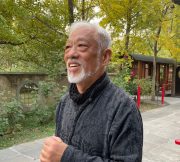Li Xianting is a key figure in the development of Chinese avant-garde art and a highly respected independent art critic and curator, often referred to as the “Godfather of Chinese Contemporary Avant-Garde Art”. As the magazine editor at Meishu magazine during Chinese economic reform, he introduced influential art movements such as “Scar Art,” “Rural Art,” and the modernistic “Twelve Artists Group Exhibition”, China’s first modernist show since mid-century. Li Xianting was the only critic to positively review the “Stars Art Exhibition” in a state-owned art magazine.
Li Xianting was the editor of three influential art magazines in China: Meishu (1978-1983), Art Newspaper of China (1985-1989), and The Renaissance (Xin Chao) (2001), and also contributed in the editing of other journals such as Art Trends (Meishu Sichao) and His contributions to the “85 New Wave” and his ongoing research and writing on Chinese art since the 1970s have solidified his status as a leading art critic. His articles, such as “Critique of the May Fourth Art Revolution” “What Matters is Not Art” “‘Postmodern’, ‘Nationalization’ and ‘Straw’” “The Sense of ‘Boredom’ in Contemporary Chinese Art: Analyzing the Cynical Realism Trend”, are now essential references for researching contemporary Chinese art.
In 1991, Li published “The Sense of ‘Boredom’ in Contemporary Chinese Art: Analyzing the Cynical Realism Trend” on on the Hong Kong academic journal, Twenty-First Century, giving Fang Lijun and his contemporaries’ new works a novel designation that had no precedent in modern art history. His article “Political Pop and Consumer Imagery” organizes the artworks from Wang Guangyi and Zhang Peili. On Chinese Calligraphy Studies, Li published “Questioning ‘Modern Calligraphy’”, as a systematic exposition on the modernization of calligraphy as a traditional art.
In his spare time, Li also finds joy in practicing calligraphy. Graduating from the Central Academy of Fine Arts in the late 1970s, he has been using a brush as his writing tool since childhood, a skill he has honed for decades. He possesses the distinct characteristics of a traditional intellectual. Since 2006, he has founded and directed the Li Xianting Film Fund, a project dedicated to the screening, education, and archiving of independent Chinese documentaries.
Despite his academic journey, Li Xinting finds solace in calligraphy. He has a passion in writing large and bold characters, distinct from the works of professional calligraphers. In recent years, he has chosen a more secluded lifestyle, yet remains committed to his artistic endeavours.
Education
- 1978 | Graduated from Chinese Painting Department at Central Academy of Fine Arts, Beijing, China
CV - 1978-1983 | Magazine Editor at Meishu
- 1985-1989 | Magazine Editor at Art Newspaper of China
- 1991 | Published “The Sense of ‘Boredom’ in Contemporary Chinese Art: Analyzing the Cynical Realism Trend” on the Hong Kong academic journal, Twenty-First Century
- 1991 | Published “Questioning ‘Modern Calligraphy’” on Chinese Calligraphy Studies, provided a comprehensive analysis of the modernization of calligraphy as a traditional art form
- 1993-1997 | Participated in the curation of “China’s New Art, Post-1989” in Hong Kong, Australia, and North America
- 1995 | Participated in the curation of “Departing from State Ideology” in Hamburg, Germany
- 1999 | Participated in the curation of “Rainbow Across the Century: Chinese Kitsch Art” in Tianjin, China
- 2000 | Participated in the curation of “Fascination with Harm” in Beijing, China
- 2001 | Magazine Editor at The Renaissance
- 2003 | Participated in the curation of “Prayer Beads and Brush Strokes” in Beijing, China
- 2006 | Founded “Xianting Film Fund”, a project dedicated to the screening, education, and archiving of independent Chinese documentaries
For full CV and biography details, please contact the gallery at enquiry@ipreciation.com

